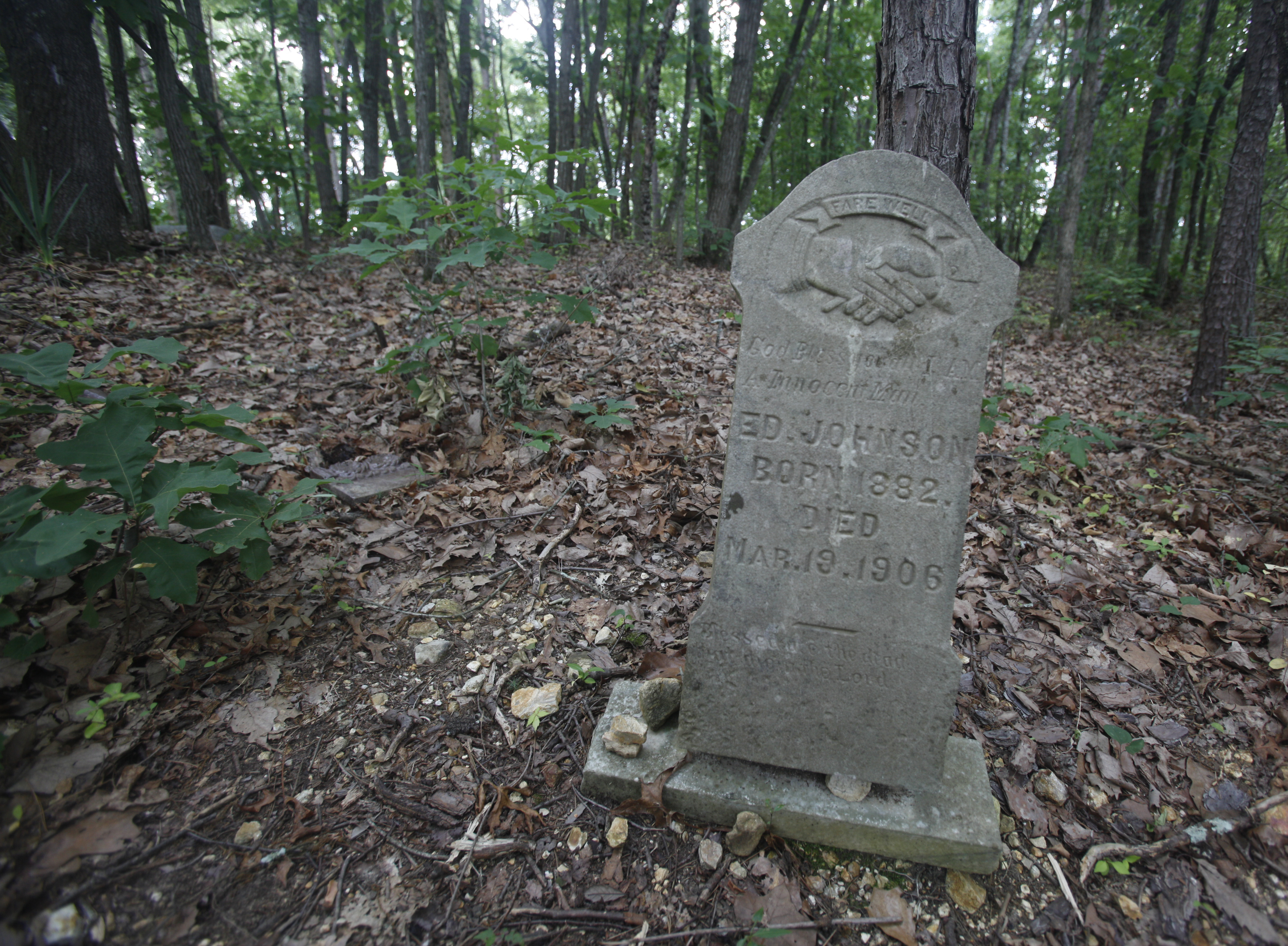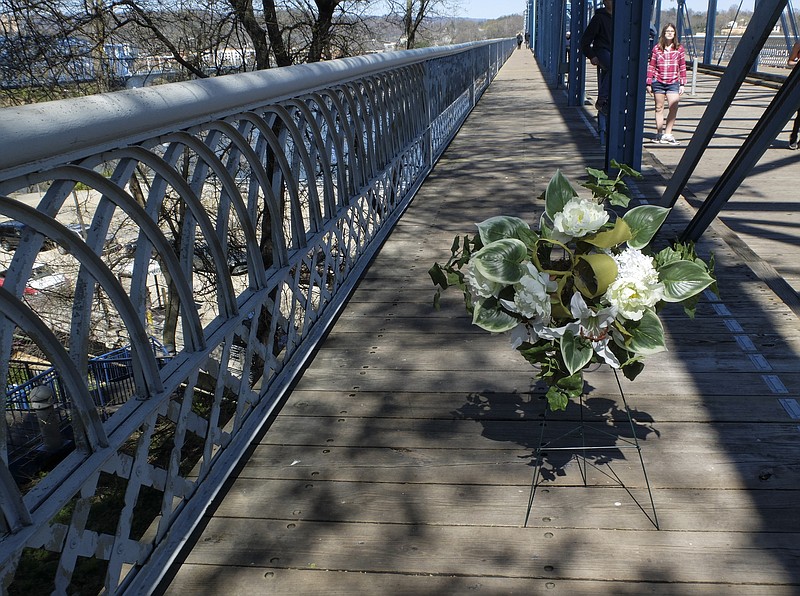 Pictured is the headstone of Ed Johnson {CQ}, who was lynched on the Walnut Street Bridge in 1906, on Tuesday, May 29, 2012. Pleasant Garden cemetery, a historically black cemetery, has been seemingly neglected for decades, despite the occasional surge of community interest. David Young {CQ}, a resident of the Ridgeside community whose home backs onto the cemetery property, has been fighting the underbrush and rampant foliage growth for three decades.
Pictured is the headstone of Ed Johnson {CQ}, who was lynched on the Walnut Street Bridge in 1906, on Tuesday, May 29, 2012. Pleasant Garden cemetery, a historically black cemetery, has been seemingly neglected for decades, despite the occasional surge of community interest. David Young {CQ}, a resident of the Ridgeside community whose home backs onto the cemetery property, has been fighting the underbrush and rampant foliage growth for three decades.For more information
› To learn more about the Ed Johnson Memorial project or to help, contact Mariann Martin at mariann.martin@gmail.com or call 706-980-5824. Readers also may go to www.edjohnsonstory.com.› To see a preview of the film, go to https://vimeo.com/199771838.
About a decade before his death in 2011, criminal defense attorney Leroy Phillips Jr. walked educator LaFrederick Thirkill into an overgrown cemetery to show him the tombstone and share more of the story of Ed Johnson, a Chattanooga man who was lynched on the Walnut Street Bridge at the turn of the 20th century.
That was 17 years ago, and Thirkill hasn't stopped telling the Ed Johnson story yet.
"It was almost like he was passing me the baton," says Thirkill about Phillips. "It's one of those stories that when you get involved with it, it doesn't let you go."
Thirkill, now principal of Orchard Knob Elementary School, spoke before nearly two dozen people at Workshop Chattanooga last month after filmmaker Linda Duvoisin showed a portion of her documentary, "I Am a Innocent Man: The Ed Johnson Story."
Duvoisin, a Chattanooga resident, has been involved with the Ed Johnson story since 1999 when she started helping Thirkill clean up the Pleasant Garden Cemetery on Missionary Ridge, where Johnson is buried.
Her documentary includes interviews with Phillips, who studied the Johnson story for 30 years and co-wrote the book "Contempt of Court" with legal journalist Mark Curriden. Duvoisin also interviewed Curriden and senior U.S. District Judge Curtis L. Collier of Chattanooga.
Last month marked the 111th anniversary of Johnson's lynching. He was murdered March 19, 1906.
It's not a story to bring shame to Chattanooga, but reconciliation, says Thirkill. But before there is reconciliation, the truth must be told.
Duvoisin and Thirkill are among dozens of people forming the Ed Johnson Memorial Committee to spread the Ed Johnson story to others.
They want to raise $525,000. The majority of it, $400,000, will be used to construct a memorial to Johnson at the Walnut Street Bridge. About $100,000 is needed to complete the documentary, and $25,000 will go toward the Ed Johnson Scholarship Fund that Thirkill founded in 2006. The fund, managed by the Chattanooga Community Foundation, has supported three Chattanooga students majoring in criminal justice, says Thirkill.
The group intends to use Johnson's story as the centerpiece for dinners and documentary showings that promote racial reconciliation in a city where just two years ago a local study indicated that inequality for Chattanooga was becoming "the new normal."
Johnson's "life and death changed the course of justice in America forever," Duvoisin said before presenting her documentary last month.
For at least 50 years before Johnson's death, not a single person involved in what is estimated to be thousands of lynchings ever went to jail, according to Curriden.
But after Johnson's lynching, courts and law enforcement held people more accountable.
Duvoisin's documentary tells the story of Johnson, a 24-year-old Chattanooga man accused of raping 21-year-old Nevada Taylor. The local court found Johnson guilty even though Taylor refused to swear that Johnson was the man who assaulted her and more than a dozen eyewitnesses said he was at work at the time of the rape. Local law enforcement officials did not take the witnesses seriously because they were African-American, says Duvoisin.
Johnson wasn't arrested immediately. Curriden's research indicated that the lack of an arrest in the case upset some residents. So two days after the alleged rape, Sheriff Joseph Shipp and Hamilton County Judge Samuel D. McReynolds announced a $375 award. Both men were up for re-election in a few months.
A white man named Will Hixson read about the reward in the newspaper and came forward saying that he saw Johnson carrying a leather strap near the scene of the crime. Taylor said the assailant put a leather strap around her throat, according to a June 2, 2009, article, "A Supreme Case of Contempt," Curriden wrote for the ABA Journal.
Johnson professed his innocence until his death.
"It appeared when we looked back at it that Johnson was just picked," says Duvoisin. "It was a random accusation. Will Hixson got an award of [over] $300, which was a lot of money in that day. It is what people made in a whole year."
Duvoisin calls the trial one of pretense where there was no chance for Johnson to be found innocent.
His murder, she says, shook the judicial system around the country.
President Theodore Roosevelt was so disturbed by the lynching that he sent Secret Service agents to Chattanooga to investigate Sheriff Shipp, whose job was to keep Johnson safe until his trial.
The investigation led to Shipp being charged with contempt of court. It was the only criminal trial ever held in the history of the nation's highest court, according to Curriden.
The trial also made a name for Noah W. Parden, who became the first African-American to argue as lead counsel before the U.S. Supreme Court. He worked on the case with Styles Hutchins, the first African-American to practice law in Georgia, says Thirkill.
Laurie Perry Vaughen, among two dozen people at the recent Workshop Chattanooga, says the hair on the back of her neck stood up when Thirkill said Johnson was employed as a day laborer who built a rock church in St. Elmo and worked a second job at a nightclub before he was arrested.
Vaughen believes she attends the church that Johnson helped to build - Thankful Memorial Episcopal Church, a small, single-aisle stone church on West 43rd Street.
She hopes her church hosts one of the dinners to discuss the documentary and racial reconciliation. At each dinner, the host supplies the meal and members of the Ed Johnson committee share Johnson's story and information on the documentary.
"Every Sunday I sit there and look at those stones and just think about the architecture of the place," says Vaughen. "Now I will sit there and know that Ed Johnson touched those stones. And I would say he has become a cornerstone in American constitutional history."
Contact Yolanda Putman at yputman@timesfreepress.com or 423-757-6431.
